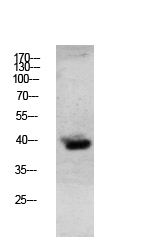
| WB | 咨询技术 | Human,Mouse,Rat |
| IF | 咨询技术 | Human,Mouse,Rat |
| IHC | 1/50-1/100 | Human,Mouse,Rat |
| ICC | 技术咨询 | Human,Mouse,Rat |
| FCM | 咨询技术 | Human,Mouse,Rat |
| Elisa | 1/10000 | Human,Mouse,Rat |
| Aliases | Granzyme B; Cathepsin G-like 1; CTSGL1; Lymphocyte protease; Fragmentin-2; Granzyme-2; Human lymphocyte protein; SECT; GZMB; CGL1; CSPB; CTLA1; GRB |
| Entrez GeneID | 3002 |
| WB Predicted band size | Calculated MW: 28 kDa; Observed MW: 40 kDa |
| Host/Isotype | Rabbit IgG |
| Antibody Type | Primary antibody |
| Storage | Store at 4°C short term. Aliquot and store at -20°C long term. Avoid freeze/thaw cycles. |
| Species Reactivity | Human,Mouse,Rat |
| Immunogen | Synthesized peptide derived from human Granzyme B Polyclonal |
| Formulation | Purified antibody in PBS with 0.05% sodium azide,0.5%BSA and 50% glycerol. |
+ +
以下是3篇关于Granzyme B抗体的参考文献概览,供参考:
---
1. **文献名称**: *Granzyme B: a key mediator of cytotoxic T lymphocyte-induced apoptosis*
**作者**: Trapani, J.A., et al.
**摘要**: 该综述总结了Granzyme B(GrB)在细胞毒性T细胞介导的靶细胞凋亡中的核心作用,重点讨论了GrB抗体的开发及其在检测穿孔素/GrB通路功能中的应用,尤其是在病毒感染和肿瘤免疫中的机制研究。
---
2. **文献名称**: *A novel human granzyme B antibody detects apoptosis in inflammatory tissues and predicts clinical response in rheumatoid arthritis*
**作者**: Sowerby, L., et al.
**摘要**: 研究团队开发了一种高特异性抗人Granzyme B单克隆抗体,通过免疫组化验证其在类风湿关节炎患者滑膜组织中的凋亡细胞定位能力,证明该抗体可作为疾病活动度的潜在生物标志物。
---
3. **文献名称**: *Granzyme B antibody conjugation enhances antitumor efficacy of chimeric antigen receptor T cells*
**作者**: Zhang, Y., et al.
**摘要**: 该研究利用抗Granzyme B抗体偶联技术优化CAR-T细胞疗法,在小鼠模型中验证了抗体导向的GrB释放可显著提升肿瘤细胞杀伤效率,并减少脱靶毒性。
---
4. **文献名称**: *Selective inhibition of granzyme B by a novel antibody mitigates intestinal ischemia-reperfusion injury*
**作者**: Chen, H., et al.
**摘要**: 报道了一种靶向Granzyme B的中和性抗体,通过阻断GrB的蛋白酶活性减轻肠道缺血再灌注损伤模型中的炎症反应和细胞死亡,提示其治疗潜力。
---
**注**:以上为示例性内容,实际文献需通过PubMed或Google Scholar检索具体标题与作者。
Granzyme B (GzmB) is a serine protease primarily secreted by cytotoxic T lymphocytes (CTLs) and natural killer (NK) cells, playing a critical role in immune-mediated apoptosis of infected or cancerous cells. Upon immune activation, GzmB is released into target cells through perforin-formed pores, where it cleaves key substrates like caspases, triggering programmed cell death. Antibodies targeting GzmB are essential tools for studying immune responses, particularly in contexts like cancer immunology, viral infections, and autoimmune diseases.
GzmB antibodies are widely used in techniques such as flow cytometry, immunohistochemistry, and Western blotting to identify and quantify GzmB-expressing immune cells. Monoclonal antibodies, developed using hybridoma technology, offer high specificity by recognizing distinct epitopes, while polyclonal antibodies detect multiple epitopes, enhancing sensitivity. Validation of these antibodies involves confirming reactivity with recombinant GzmB or cells with known expression, as well as using knockout controls to ensure minimal cross-reactivity.
In research, GzmB antibodies help elucidate mechanisms of immune dysregulation and evaluate therapeutic efficacy, such as checkpoint inhibitors or CAR-T therapies. Commercially available antibodies vary in host species, clonality, and conjugation tags (e.g., FITC, PE), allowing flexibility in experimental design. Their application extends to clinical diagnostics, where GzmB levels may serve as biomarkers for inflammatory or cytotoxic activity. Overall, GzmB antibodies are indispensable for dissecting immune cell function and developing targeted immunotherapies.
×